A 2-day Private Tour Wader Weekend in North Norfolk. The specific brief was to pick a weekend where we could catch up with some returning waders. It might seem like summer to us, but late July is a great time for return autumn wader migration. We were blessed with some nice weather too, sunny and warm, with a bit of a sea breeze.
Saturday 27th July
It was a big high tide today, not big enough for a full Spectacular but plenty high enough to bring all the waders in from the Wash close enough to see. With the added bonus that there had been a few rarities seen there in the last few days too. We met in Wells and headed up to Snettisham early this morning.
One of the drawbacks of too much coffee at breakfast is regular stops later in the morning. After an unplanned stop on the way out, we unfortunately arrived out on the Wash just as all the waders were flushed by a couple of Arctic Skuas. The Semipalmated Sandpiper had been showing well on the mud out from Rotary Hide but flew up in the melee and disappeared. We were at least treated to some nice whirling flocks of Knot out over the mud (it was WeBS count day today and apparently there were 30,800 Knot here!).
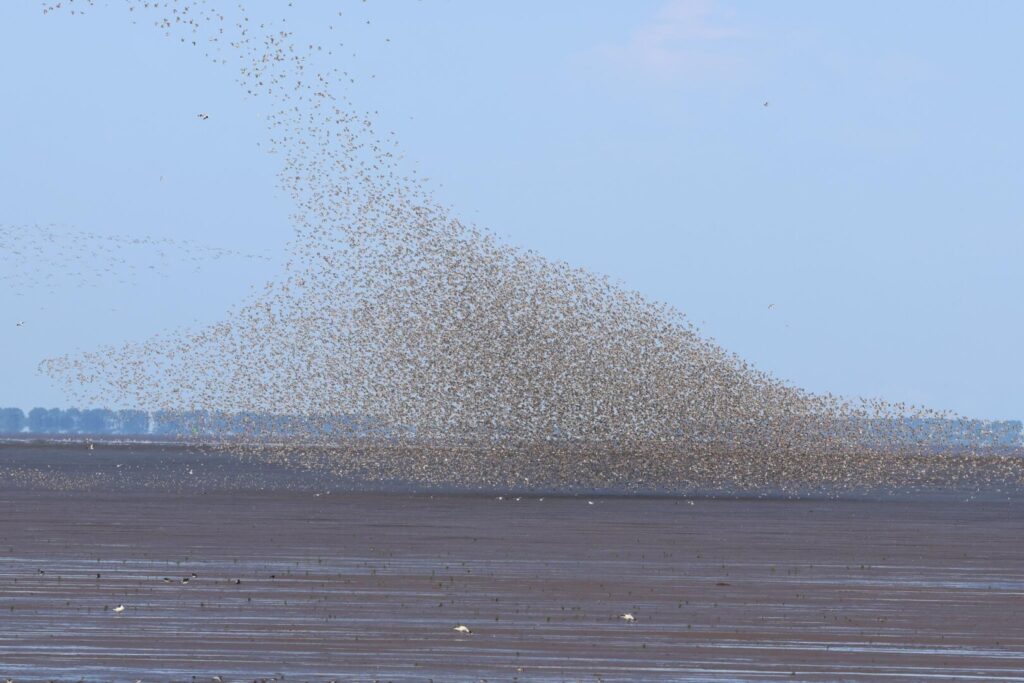
We stood and watched the rising tide and looked through all the waders which were pushed in. There were lots of Dunlin and Sanderling and in with them we found two or three Curlew Sandpipers and a couple of Little Stints. As well as the Knot, there were flocks of Bar-tailed Godwits, some still in breeding plumage, plenty of Curlew and a few Grey Plover. There were lots of terns too – Sandwich, Common and Little Terns.
As we followed the tide down to the end, we stood and watched the march of the Oystercatchers away from the rising water (over 3,000 on the WeBS count today). Then as the water reached the last corner of mud, the Knot started fly up in huge flocks to swirl round. Some huge flocks, several thousand strong, flew in over our heads – we stood and listened to the beating of their wings. Most of the Knot turned back out and landed in the last sliver of remaining mud as the tide went slack.
In to Shore Hide, there was at least one Curlew Sandpiper now roosting in with the Knot and Dunlin on the island in the Pit just to the north. We also got the scopes on the 11 Spotted Redshanks which were roosting out in the middle, one still partly in black breeding plumage but most now looking silvery grey.
A message came through to say that one of the White-rumped Sandpipers had been picked up from South Screen so we made our way down there next. The Screen was packed out and we had to queue to get an initial view. Then we realised we could get a better look from the ‘Knot’s Landing’ hide next door. We got the scopes on it and had a great view from here, roosting helpfully on the front end of the flock, occasionally stretching and flashing its white rump.
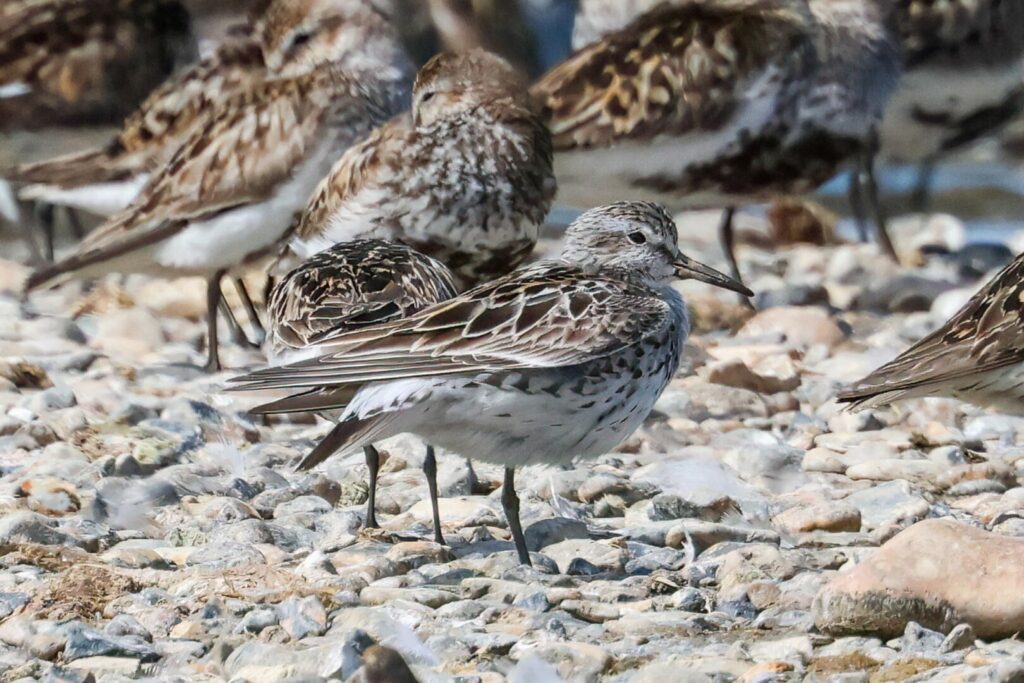
There was a lovely moulting adult Curlew Sandpiper in the middle of all the Knot and Dunlin gathered on the island here too. A few Turnstone were on the edge of the next island over, still in smart breeding plumage. A couple of Common Sandpipers were patrolling the edge of the water. A single Spoonbill was asleep on the bank.
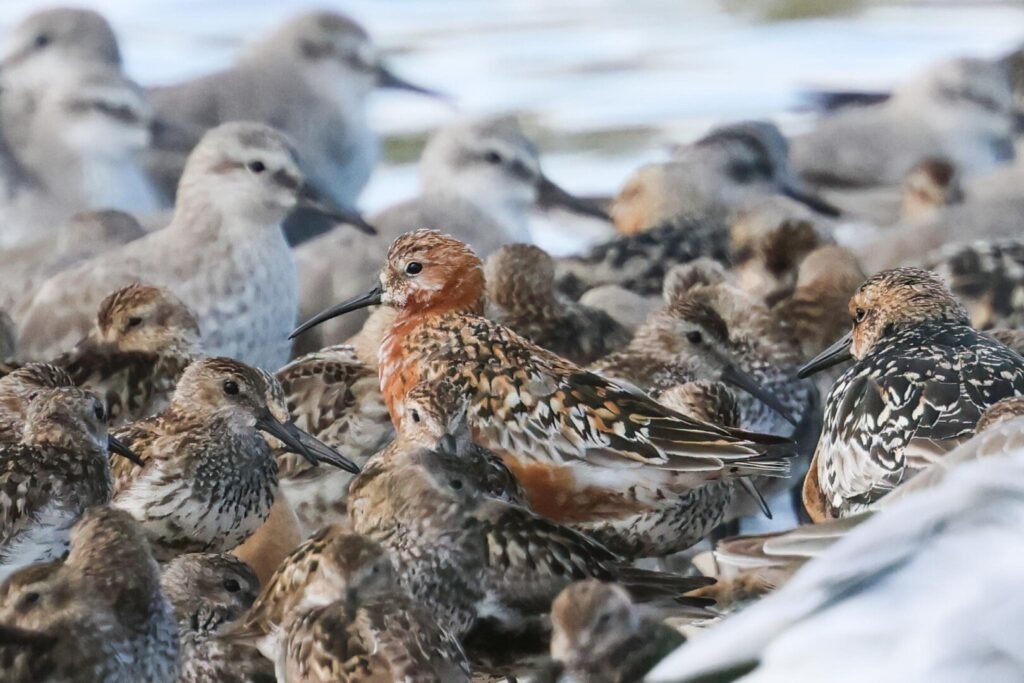
Someone phoned us to say that the Semipalmated Sandpiper had been seen on the beach back up by the chalets, so we walked back round. We had only got half way though before he rang again to say that there was no sign of it. Several people were gathered now looking through the Sanderling, Dunlin and Ringed Plovers roosting on the beach. Several breeding plumage Turnstones were feeding on the shore. A Yellow Wagtail flew in and landed with all the waders on the stones and a 1st summer Little Gull was out on the water with the Mediterranean Gulls.
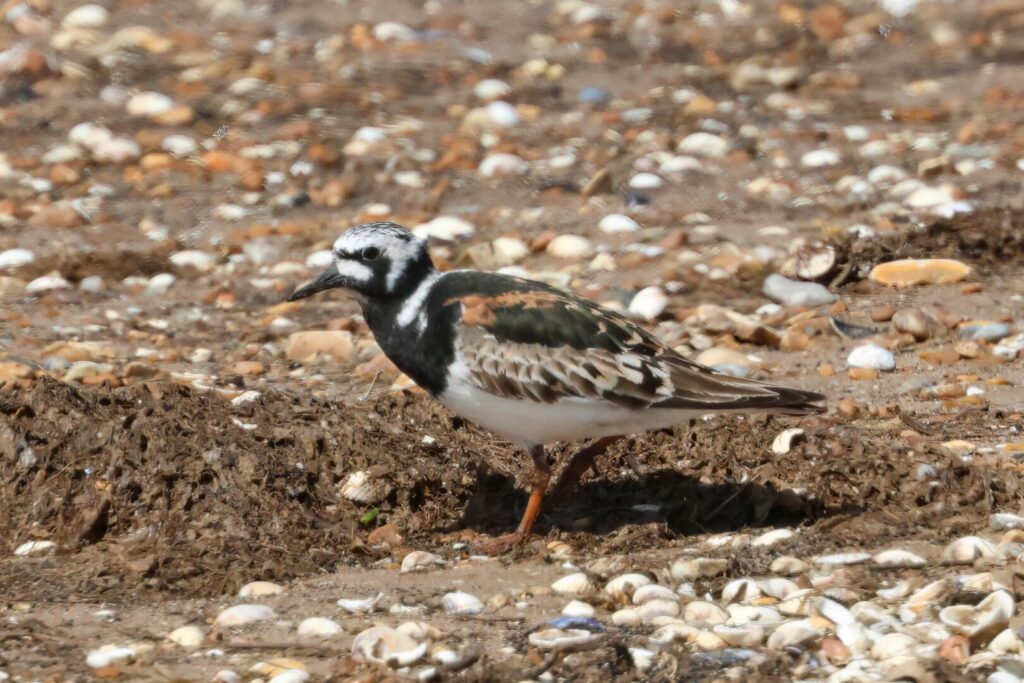
We stood and watched as the tide quickly went out again now before deciding it was time to head back. It was already lunch time, so we made our way round to Titchwell for the rest of the afternoon. After a break and something to eat in the picnic area, we headed out to explore the reserve. A Marsh Harrier was over the back of the reedbed and a Bearded Tit flew over one of the channels as we passed. From Island Hide, there were lots of Black-tailed Godwits and Avocets on the Freshmarsh, and a few Ruff in different stages of moult.
The Temminck’s Stint had not been seen all morning but then had been reported from Parrinder Hide again while we were eating lunch. By the time we got out there it had disappeared again, walked round the back of one of the islands. The only thing which walked back out again was a juvenile Dunlin. There were a couple of Little Stints from here on the edge of one of the other islands. A single Green Sandpiper and a Spotted Redshank were over the far side. When all the waders were flushed by a Marsh Harrier, a single Golden Plover flew over with a small flock of Starlings.
We decided to head out to the beach and call in again for another look on our way back. The tide was out now and there were only a few waders on Volunteer Marsh and the Tidal Pools, including several Little Ringed Plovers. Out on the beach, there were lots of waders feeding on the mussel beds now and scanning through we managed to find a couple of Whimbrel in with the other species. At one point, one of the Whimbrel was feeding next to a Curlew, a nice side by side comparison. A single drake Common Scoter was out on the sea.
Back at Parrinder Hide, there was still no further sign of the Temminck’s Stint, but there was a Wood Sandpiper now hiding in the far NE corner of the Freshmarsh. Eventually it emerged properly along the edge, feeding with a Common Sandpiper at one point. It was time to head back, but we stopped briefly to admire a fresh juvenile Continental Black-tailed Godwit which was feeding close to the main path.

More tomorrow.
Sunday 28th July
Our first destination for the morning was Stiffkey Fen. As we drove along the coast road, we stopped briefly overlooking the flood just east of the village. A single Cattle Egret was in with the cows and a couple of Green Sandpipers were on one of the pools.
There were lots of butterflies and dragonflies on the walk out to the Fen and a Spoonbill flew over. From up on the seawall, we could see 27 Spoonbills still out on the pool. There were at least four Common Sandpipers and a single Green Sandpiper around the edges of the islands too. With the tide coming in out in the harbour, a succession of small flocks of Redshank flew in to roost. There were a few Greenshank out on the Fen with them.
As we walked on down the path another Common Sandpiper was feeding on the channel. From round at the corner we looked out over the harbour. It was still some time to high tide and there was still plenty of mud. But looking carefully through the roosting gulls we managed to find a 3rd summer Caspian Gull. It was asleep at first, until a child ran off from its parents who were playing with their kids in the channel and out over the mud to flush all the gulls. Thankfully the Caspian Gull landed again a little further over and we got a proper look at it.
On the walk back, we found our first Painted Lady of the year, nectaring on the thistles in the field. It has not been a good year for butterflies, with all the cold wet weather up until the last couple of weeks. Back at the minibus, our first Migrant Hawker of the year was hawking in the lee of the pines.
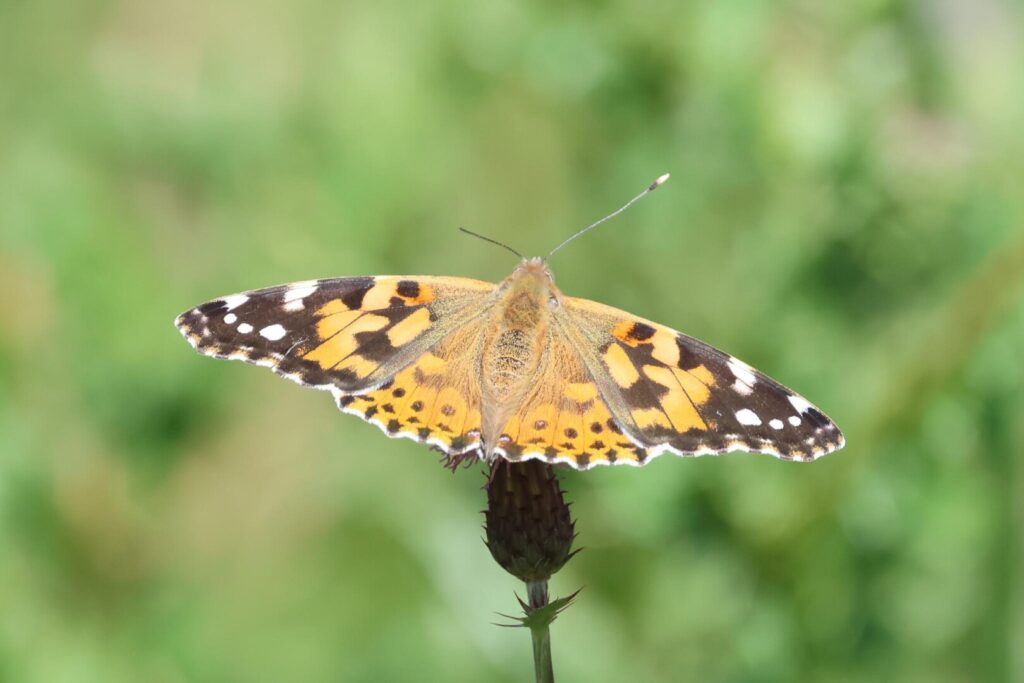
We drove on to Cley next. After a quick stop at the Visitor Centre to use the facilities and to see a Goat Moth which had been caught by one of the regular local moth-ers overnight, we still had a bit of time before lunch. We drove round to the beach car park for a quick seawatch. There were a few Sandwich Terns fishing offshore and we managed to spot three distant Arctic Skuas chasing terns out in front of the wind turbines. A couple of Gannets and a few small groups of Common Scoter flew past.
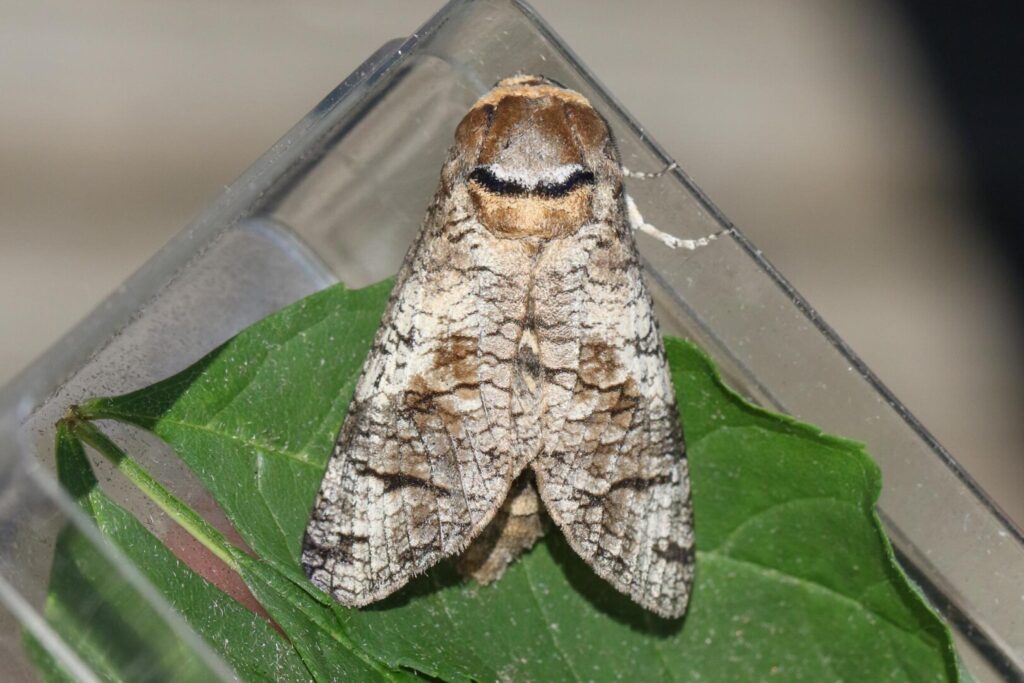
Over lunch back in the picnic area by the Visitor Centre, we could see lots of Cattle Egrets out with the cows on Pat’s Pool. More kept appearing out of the grass and eventually we counted at least 27 – the biggest flock we have ever seen in Norfolk! There were a few Spoonbills too.
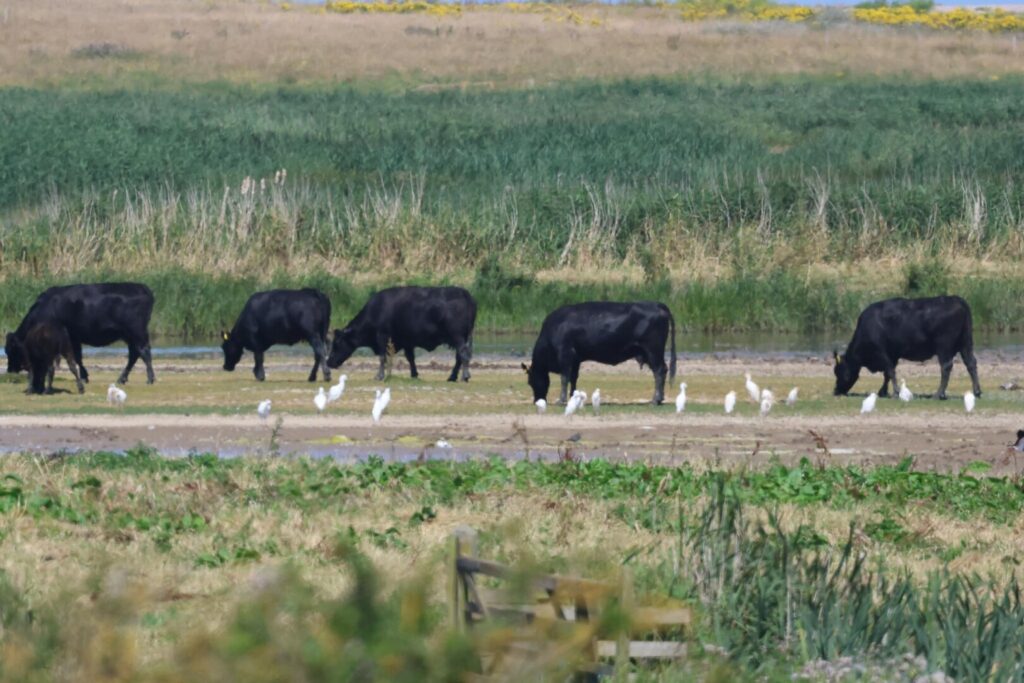
After lunch, we walked out on the East Bank. The reedbed was surprisingly quiet and surpisingly we didn’t hear a single Bearded Tit today. There were a few Reed Warblers and a Sedge Warbler flew past. One or two Great White Egrets appeared up out of the reedbed pool. The Serpentine produced three Common Snipe, our first of the weekend, plus a single Common Sandpiper. We could see plenty of Black-tailed Godwits and a few Ruff on Pope’s Pool beyond. A Whimbrel flew W along the shingle ridge.
Out at Arnold’s Marsh, there were lots of Sandwich Terns roosting on the islands. We could see a good number of juveniles and several adults flew in from the sea bringing fish. Three Knot were feeding with a small flock of Dunlin and we picked up a single Greenshank. The pair of Ringed Plovers still have several chicks – they are growing up fast now, but were mostly hiding under the Suaeda bushes today.
A quick look at the sea produced much the same as we had seen earlier from the beach car park, so we decided to walk back. We still had time for one last quick stop on our way back to Wells so we drove down to the pools at North Point. The water level is still high on the east pool, but there were two Spoonbills feeding at the back and a couple of Green Sandpipers by the rushes. In contrast, the middle pool is almost drying out but there were three more Green Sandpipers on here.
We walked on through the bushes, where there were a few Blackcaps calling, and up onto the seawall beyond. The water level on the west pool looked ideal but all we could find here today were yet another two Green Sandpipers. Then it was time to call it a day and head back.
So a very successful Wader Weekend all told, with 26 different species seen.
















